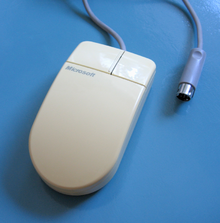Bus mouse
This article relies largely or entirely on a single source. (January 2022) |
 A Microsoft InPort bus mouse adapter, in the form of an 8-bit ISA (XT-bus) card | |||
| Type | Computer mouse input port | ||
|---|---|---|---|
| Production history | |||
| Designer | Microsoft | ||
| Designed | late 1980s | ||
| Produced | 1980s to 2000 | ||
| Superseded by | PS/2 port, USB (2000) | ||
| General specifications | |||
| External | Yes | ||
| Cable | 9 wires plus shield | ||
| Pins | 9 | ||
| Connector |
Mini-DIN-9 | ||
| Data | |||
| Data signal | 30–200 Hz (interrupt mode) with 3 button state signals and quadrature signals for mouse movement | ||
| Pinout | |||
 | |||
| Female port pin layout from the front | |||
| Pin 1 | SW2 | Mouse button 2 | |
| Pin 2 | SW3 | Mouse button 3 | |
| Pin 3 | GND | Ground | |
| Pin 4 | XB | X position | |
| Pin 5 | YA | Y position | |
| Pin 6 | YB | Y position | |
| Pin 7 | SW1 | Mouse button 1 | |
| Pin 8 | Vcc | +5 V Power | |
| Pin 9 | XA | X position | |
| XA/XB and YA/YB indicate movement and direction based on quadrature phase. | |||
A bus mouse is a variety of PC computer mouse which is attached to the computer using a specialized interface (originally, the Microsoft InPort interface developed for Microsoft's original mouse product).


In the late 1980s, mice were not integrated with IBM-compatible personal computers, and the specialized bus interface (implemented via an ISA add-in card) was one of two popular ways to connect a mouse; serial interfaces were the other method. In addition to Microsoft, Logitech also made bus mouse interface cards.
When the IBM PS/2 was introduced, it included a motherboard mouse interface which was integrated with the keyboard controller (still called the PS/2 mouse interface long after the PS/2 brand was withdrawn); this fairly quickly drove the bus mouse design out of the marketplace.
The bus mouse lived on in the
See also
Further reading
- Paul, Matthias R. (2002-04-06). "Re: [fd-dev] ANNOUNCE: CuteMouse 2.0 alpha 1". freedos-dev. Archived from the original on 2020-02-07. Retrieved 2020-02-07.
[…] The original
I/O addresses[…]
External links
- "Mouse Connector". Archived from the original on 2010-07-31. Retrieved 2006-10-27.
